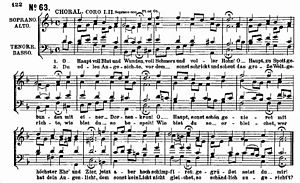
Back Koraal (musiek) Afrikaans Харал Byelorussian Хорал Bulgarian Coral Catalan Koral (musik) Danish Choral German Ĥoralo Esperanto Coral (música) Spanish Koraal Estonian Koraali Finnish

A chorale is the name of several related musical forms originating in the music genre of the Lutheran chorale:
- Hymn tune of a Lutheran hymn (e.g. the melody of "Wachet auf, ruft uns die Stimme"), or a tune in a similar format (e.g. one of the themes in the Finale of Saint-Saëns's Third Symphony)
- Such tune with a harmonic accompaniment (e.g. chorale monody, chorales included in Schemellis Gesangbuch)
- Such a tune presented in a homophonic or homorhythmic harmonisation, usually four-part harmony (e.g. Bach's four-part chorales, or the chorale included in the second movement of Mahler's Fifth Symphony)
- A more complex setting of a hymn(-like) tune (e.g. chorale fantasia form in Bach's Schübler Chorales, or a combination of compositional techniques in César Franck's Three Chorales)
The chorale originated when Martin Luther translated sacred songs into the vernacular language (German), contrary to the established practice of church music near the end of the first quarter of the 16th century. The first hymnals according to Luther's new method were published in 1524. Luther and his followers not only wrote metrical hymn lyrics, but also composed metrical musical settings for these texts. This music was partially based on established melodies of church hymns and known secular songs. In the 17th century the repertoire was enriched with more choral and organ settings of the chorale tunes. By the end of the century a four-part setting for SATB voices had become the standard for the choral settings, while the congregational singing of chorales was tending towards monody with an instrumental accompaniment. The prolific creation of new Lutheran chorale tunes ended around that time.
The cantata genre, originally consisting only of recitatives and arias, was introduced into Lutheran church services in the early 18th century. The format was soon expanded with choral movements in the form of four-part chorales. Composers such as Johann Sebastian Bach and Gottfried Heinrich Stölzel often placed these chorales as the concluding movement of their church compositions. The chorale finale was emulated in more secular genres such as Romantic 19th-century symphonies. Other composers of that era, such as Franck, expanded the repertoire of the organ chorale, also emulating what late Baroque composers such as Bach had produced more than a century before. Entirely new chorale compositions became rare after the Romantic era, but by that time the four-part harmonization technique, as exemplified in four-part chorales, had become part of the canon of Western music.